5 Steps to Get Unstuck When Sight-Reading

This article comes from Jessica Homewood at Not Your Mother's Piano Studio!
Sight-reading is a game-changer, allowing musicians to play music on the spot without prior practice. It's like deciphering musical code! But for beginners, sight-reading can feel like a daunting challenge. Here are five practical steps that will help you conquer sight-reading obstacles and take your musician skills to the next level.
Step 1: Get Your Head in the Game with Mindset
Do your best to approach sight-reading with a positive and focused mindset, embracing the fact that sight-reading is a skill that is developed over time with a consistent practice strategy.
Professional pianist Ashlee Young gives the best tips for being strategic with your practice.
Every well-accomplished musician started as a beginner. It doesn't come overnight, nor should you expect it to.
Step 2: Scan and Analyze the Roadmap
Many musicians like to start playing before they’ve even taken a look at their piece fully! Before you dive into playing, take a moment to scan the music and analyze its key elements. Look at the key signature, time signature, tempo markings, and dynamics, and note anything else that stands out to you. This preliminary analysis will give you a heads-up on what to expect and mentally prepare you for the piece ahead–similar to the way you would analyze a roadmap before taking a road trip!
Step 3: Slow and Steady Wins the Race
Remind yourself of the importance of this infamous phrase, starting each sight-reading journey at a comfortable tempo. The goal at the beginning is always accuracy rather than speed.
As you start to get comfortable with the piece, give yourself permission to gradually increase the tempo. Again, the key is gradually. Don't need to worry about making mistakes! Mistakes are a crucial part of the learning process. Stay in control of your mindset by remaining calm and pushing forward.
Step 4: Simplify Complex Passages
Sometimes, we create our own obstacles by labeling a section as “tricky” or “difficult.” You will have a much harder time sight-reading successfully when you know you’re coming up to that mentally labeled “tricky” section. Your stress will increase, and your sight-reading will most likely suffer as a result.
Instead of labeling a passage as "tricky," break the passage down into smaller, more achievable blocks if you’re having a hard time. Practice those smaller blocks hands separately, paying attention to fingerings, rhythms, and note accuracy. Once you feel more confident with a practice block, move onto the next practice block. Finally, slowly integrate those simplified blocks back into the entire piece.
Step 5: Emphasize Musicality and Expression
Don't forget the magic ingredient of a musical performance - musicality and expression! Sight-reading isn't just about reading the notes; it's about bringing the music to life. Emphasizing musicality and expression can be a difficult concept to learn, but you can begin by trying to capture the essence of a piece by paying attention to phrasing, dynamics, and articulation.
Give yourself space to feel the music! With these steps in your musician toolbox, you will be well on your way to unlocking the power of sight-reading and taking your performances to new heights.
About The Author

Jess Homewood is a Private Piano Studio Owner and Resource Curator for Not Your Mother’s Piano Studio. Her mantra to keep piano teaching simple has led her to create Volumes 1 & 2 for THE NO PRINTOUT PLAYBOOK, a resource with easy at-home piano games that require little to no prep work or materials. She inspires piano teachers across the world to simplify their lessons and businesses to give them back their time, family life, and enthusiasm for their music teaching career. As a busy mom of two toddlers, she relates to many as she personally balances piano boss and mom boss life – without sacrificing studio growth or fun!
Jess has been a guest on The Dynamic Piano Teaching Podcast and is a featured
guest blogger at Musicnotes. She has professional partnerships with Successful Group Lessons and The Cascade Method to bring the best tried-and-tested resources to her ultimate piano resource library. You can find her resource library at www.notyourmotherspianostudio.com and @notyourmotherspianostudio on Facebook and Instagram.

